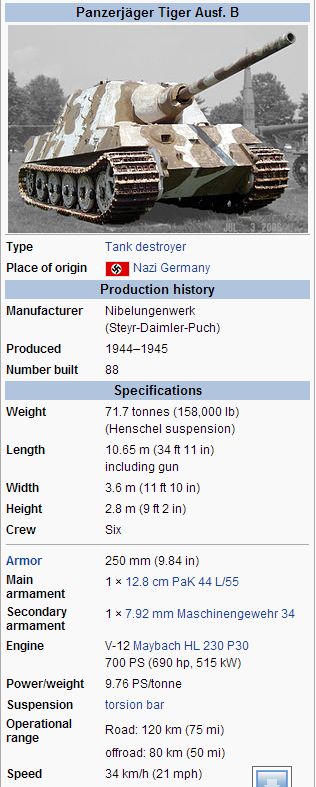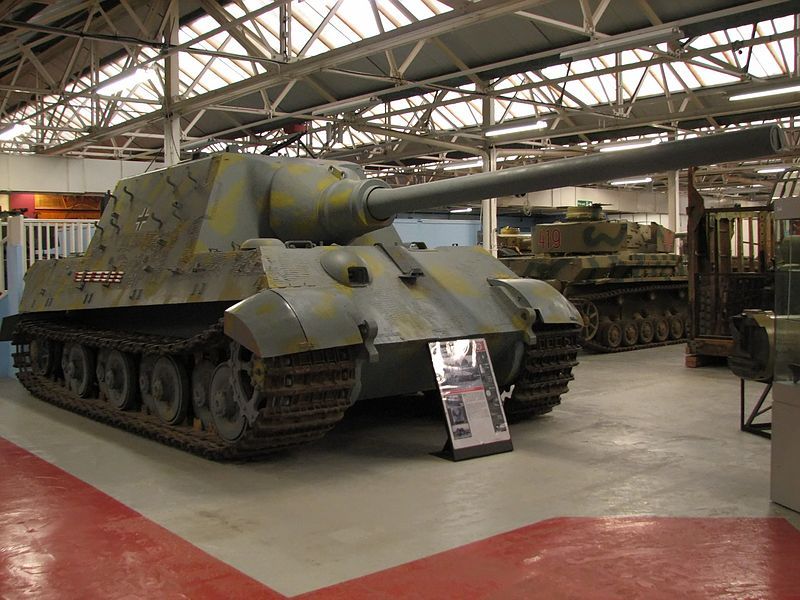
Combat history
512th Heavy Panzerjäger Battalion and 653rd Heavy Panzerjäger Battalion
Only two heavy antitank battalions (schwere Panzerjäger-Abteilung), numbered 512 and 653, were equipped with Jagdtigers, with the first vehicles reaching the units in September 1944. About 20% were lost in combat; most were destroyed by their own crews when abandoned, chiefly due to mechanical breakdowns or lack of fuel in the desperate final stages of the war.
The gun used two-part ammunition, which meant that two loaders were used to insert the projectile and the cased propelling charge separately. This resulted in a low rate of fire. The tremendous amount of smoke would often give away the position of the vehicle, in addition to momentarily blinding the crew,[citation needed] although the latter was a moot point, owing to the protracted reload time.
Tiger ace Otto Carius commanded the second of three companies of Jagdtigers in Panzerjagerabteilung 512. His memoir Tigers in the Mud provides a rare combat history of the ten Jagdtigers under his command. He states that Jagdtigers were not utilized to their full potential due to several factors: Among them that Allied air supremacy made it difficult to move, the massive gun needed to be re-calibrated from jarring after traveling off-road for even short distances[5] (Note: This particular problem was attributed more to the eight wheel Porsche type suspension which proved unfit for off-road terrain, causing excessive vibrations which over a short period could throw the gun out of calibration. More modern 9 wheel Henschel type suspension system from the King Tiger was thought to have less of this particular problem: which type Carius commanded is unknown), it was slow, and transmissions and differentials broke down easily because the whole 72 tonne vehicle needed to rotate to traverse the gun. The massive gun had to be locked down, otherwise mounting brackets would have worn too much for accurate firing. Also a crew member had to exit the vehicle in combat and unlock the gun before firing. However, he also recorded that a 128 mm projectile went through all the walls of a house and destroyed an American tank behind it.
Insufficient crew training and poor morale was the biggest problem for Jagdtiger crews under Carius' command. At the Ruhr pocket, two Jagdtiger commanders failed to attack an American armored column about 1.5 km (1 mile) away in daylight for fear of attracting an air attack, even though Jagdtigers were well camouflaged. Both vehicles broke down while hurriedly withdrawing through fear of air attack which did not come, and one was then destroyed by the crew. To prevent such disaster at Siegen, Carius himself dug in on high ground. An approaching American armored column avoided the prepared ambush because German civilians warned them of it. Later, one of his vehicles fell into a bomb crater at night and was disabled, and another was lost to Panzerfaust attack by friendly Volkssturm troops who had never seen a Jagdtiger before.
Near Unna, one Jagdtiger climbed a hill to attack five American tanks 600 meters away and below; two withdrew and the other three opened fire. The Jagdtiger took several hits, but American projectiles could not penetrate the 250 mm (9.8 in) frontal armor. However, the inexperienced German commander lost his nerve and turned around instead of backing down, exposed the thinner side armor, which was eventually penetrated and all six crew members were lost. Carius wrote that it was useless when crews were not trained or experienced enough to have the thick frontal armor facing the enemy at all times.[10]
When unable to escape the Ruhr pocket, Carius ordered the guns of the remaining Jagdtigers destroyed and surrendered to American forces. The 10 Jagdtigers of 2nd Company, Panzerjagerabteilung 512 destroyed one American tank for one Jagdtiger lost to combat, one lost to friendly fire, and eight others lost to breakdown or destroyed by their crews to prevent capture.
On 17 January 1945 two Jagdtigers used by XIV Corps engaged a bunker line in support of infantry near Auenheim. On 18 January they attacked four secure bunkers at 1,000 meters. The armored cupola of one bunker burned out after two shots. A Sherman attacking in a counter-thrust was set afire by explosive shells. The total combat included 46 explosive shells and 10 anti-tank shells with no losses to the Jagdtigers.
During April 1945, s.Pz.Jäg.Abt.512 saw a great deal of action, especially on 9 April, where the 1st company engaged an Allied column of Sherman tanks and trucks from dug-down positions, and destroyed 11 tanks and over 30 soft-skins, with some of the enemy tanks having been knocked out from a distance of more than 4,000 m. The combat unit only lost one Jagdtiger in this incident as Allied ground attack P-47 fighters appeared. During the next couple of days the 1st company destroyed a further five Sherman tanks before having to surrender at Iserlohn. Meanwhile the 2nd company still fought on, but with little result. On 15 April 1945, the unit surrendered at Schillerplatz in Iserlohn without fighting.

